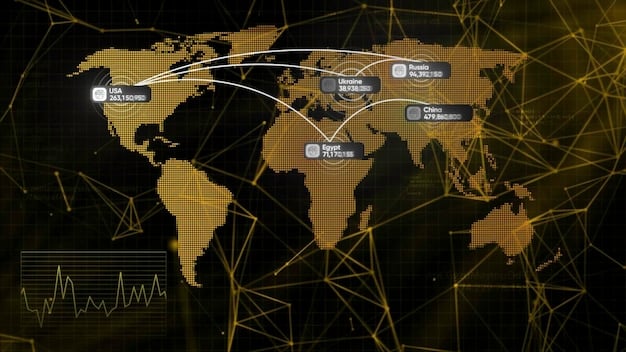Navigating Geopolitics: Adapting Your US Business Strategy in 3 Months

Adapting your US business strategy to the shifting geopolitical landscape in the next 3 months requires a comprehensive understanding of global events, economic indicators, and strategic adjustments to mitigate risks and capitalize on emerging opportunities.
The global stage is constantly evolving, and for US businesses, understanding and adapting to these changes is more critical than ever. This insider’s guide to adapting your US business strategy to the shifting geopolitical landscape in the next 3 months will equip you with the knowledge and tools necessary to navigate these uncertain times.
Understanding the Current Geopolitical Landscape
To effectively adapt your US business strategy, it’s crucial to first understand the current geopolitical landscape. This involves identifying key areas of instability, emerging alliances, and potential threats to global trade and investment.
Several factors are shaping the current geopolitical environment, including:
- Trade tensions: Ongoing trade disputes between major economic powers can disrupt supply chains and increase costs for businesses.
- Political instability: Conflicts and political unrest in various regions can create uncertainty and impact business operations.
- Technological advancements: Rapid technological changes are reshaping industries and creating new opportunities and challenges.
- Regulatory changes: Shifts in regulations, both domestically and internationally, can impact business practices and compliance requirements.

By understanding these factors, businesses can better assess the potential risks and opportunities and develop strategies to mitigate them. Staying informed on global events, economic indicators, and political developments is essential for making informed decisions and adapting to changing circumstances.
Assessing the Impact on Your US Business
Once you have a grasp of the geopolitical landscape, the next step is to assess how these factors might impact your specific business operations. This involves evaluating your supply chain, market access, and potential financial risks.
Consider the following questions:
- How reliant are you on international suppliers or markets? If your business is heavily dependent on specific regions or countries, disruptions in those areas could have a significant impact.
- What are the potential regulatory hurdles in different markets? New regulations or trade barriers can increase costs and complexity.
- How vulnerable are you to currency fluctuations? Changes in exchange rates can impact your profitability and competitiveness.
It’s also important to consider the potential impact on your employees and customers. Are there any safety concerns for employees traveling to certain regions? Could geopolitical events affect consumer sentiment and demand for your products or services?
Developing a Resilient Supply Chain
A resilient supply chain is crucial for navigating geopolitical uncertainty. This involves diversifying your suppliers, establishing backup plans, and implementing risk-management strategies.
Here are some steps you can take to strengthen your supply chain:
Diversify Your Supplier Base
Relying on a single supplier can create significant vulnerabilities. Explore alternative suppliers in different regions to reduce your dependence on any one source.
Establish Backup Plans
Develop contingency plans for potential disruptions. This could include identifying alternative transportation routes, pre-negotiating contracts with backup suppliers, and building up inventory reserves.
Invest in Technology
Utilize technology to improve supply chain visibility and coordination. This could include implementing a supply chain management system, using data analytics to identify potential risks, and establishing secure communication channels with your suppliers.

By building a resilient supply chain, you can minimize the impact of geopolitical events on your business operations and ensure that you can continue to meet the needs of your customers.
Adapting Your Market Access Strategy
Geopolitical events can also impact your market access strategy. This involves identifying new markets, adjusting your marketing efforts, and navigating trade barriers.
Identify New Markets
Explore new markets that are less vulnerable to geopolitical risks. This could involve expanding into emerging economies or focusing on regions with stable political environments.
Adjust Your Marketing Efforts
Adapt your marketing strategies to reflect the current geopolitical climate. This could involve highlighting the origin of your products, emphasizing your commitment to ethical sourcing, or addressing concerns about political instability.
Navigating Trade Barriers
Stay informed about trade agreements and regulations that affect your industry. This could involve seeking legal advice, participating in trade associations, and advocating for policies that support your business.
Managing Financial Risks
Geopolitical events can create financial risks for businesses, including currency fluctuations, interest rate changes, and economic downturns. It’s essential to develop strategies for managing these risks.
Hedge Currency Risks
Use financial instruments to hedge against currency fluctuations. This could involve buying forward contracts, using currency options, or diversifying your currency holdings.
Manage Interest Rate Risks
Consider using interest rate swaps or caps to manage interest rate risks. This can protect your business from rising borrowing costs.
Build a Strong Balance Sheet
Maintain a strong balance sheet with sufficient cash reserves to weather economic downturns. This will provide you with the financial flexibility to adapt to changing circumstances.
Leveraging Government Resources and Support
The US government offers a variety of resources and support programs to help businesses navigate the global landscape. These resources can provide valuable information, financial assistance, and advocacy on behalf of US businesses.
Here are some government agencies and programs that can be helpful:
- The US Department of Commerce: Provides information on international trade, market research, and export assistance.
- The Small Business Administration (SBA): Offers loans, grants, and counseling services to small businesses.
- The Export-Import Bank of the United States (EXIM): Provides financing and insurance to support US exports.
- The US Trade Representative (USTR): Negotiates trade agreements and advocates for US businesses in international trade disputes.
Take advantage of these resources to gain insights into global markets, access financial assistance, and advocate for policies that support your business.
| Key Point | Brief Description |
|---|---|
| 🌍 Analyze Geopolitics | Assess international trade tensions, political stability, and technological impacts. |
| 🚚 Resilient Supply Chain | Diversify suppliers, establish backup plans, and utilize technology for visibility. |
| 📈 Market Access | Explore new markets and adjust marketing based on geopolitical climate. |
| 💰 Financial Risk | Hedge currency risks and maintain a strong financial balance. |
FAQ
▼
Geopolitical risks evolve rapidly, so reassessing your analysis quarterly is a good starting point. However, major global events might warrant more frequent evaluations and strategy adjustments.
▼
Keep an eye on events like unexpected policy changes, trade disputes, election outcomes that destabilize relations, significant military movements, and sudden shifts in economic performance indicators.
▼
Start by identifying critical dependencies, researching alternative suppliers domestically and internationally, and negotiating flexible terms for smaller initial orders. Industry associations can be helpful too.
▼
Technology enables better risk monitoring, improved supply chain visibility, access to real-time market intelligence, and the ability to swiftly reconfigure operations based on updated conditions. Cloud-based solutions are especially adaptable.
▼
Subscribe to reputable global news sources, follow expert commentaries from geopolitical analysts, enroll in relevant webinars, and leverage government resources for country-specific guidance to remain current.
Conclusion
Adapting your US business strategy to the shifting geopolitical landscape requires vigilance, proactive planning, and the willingness to embrace change. By understanding the key trends, assessing the impact on your business, and implementing strategies to mitigate risks and capitalize on opportunities, you can navigate these uncertain times and position your business for long-term success.





